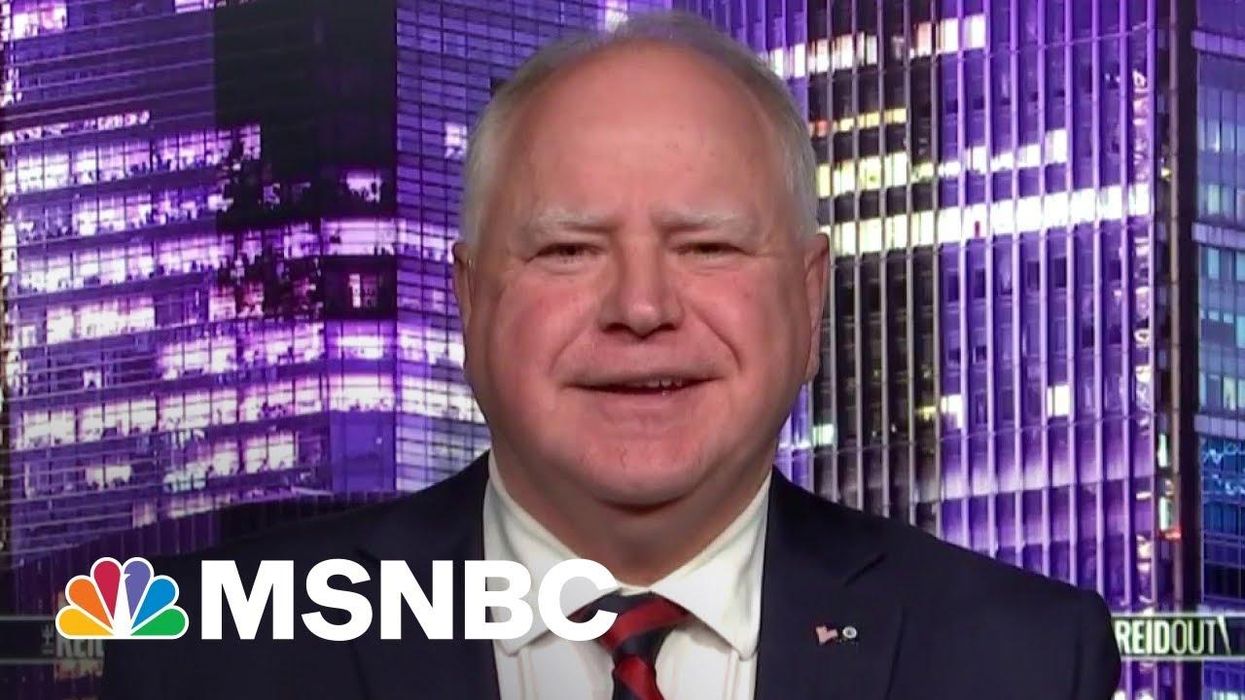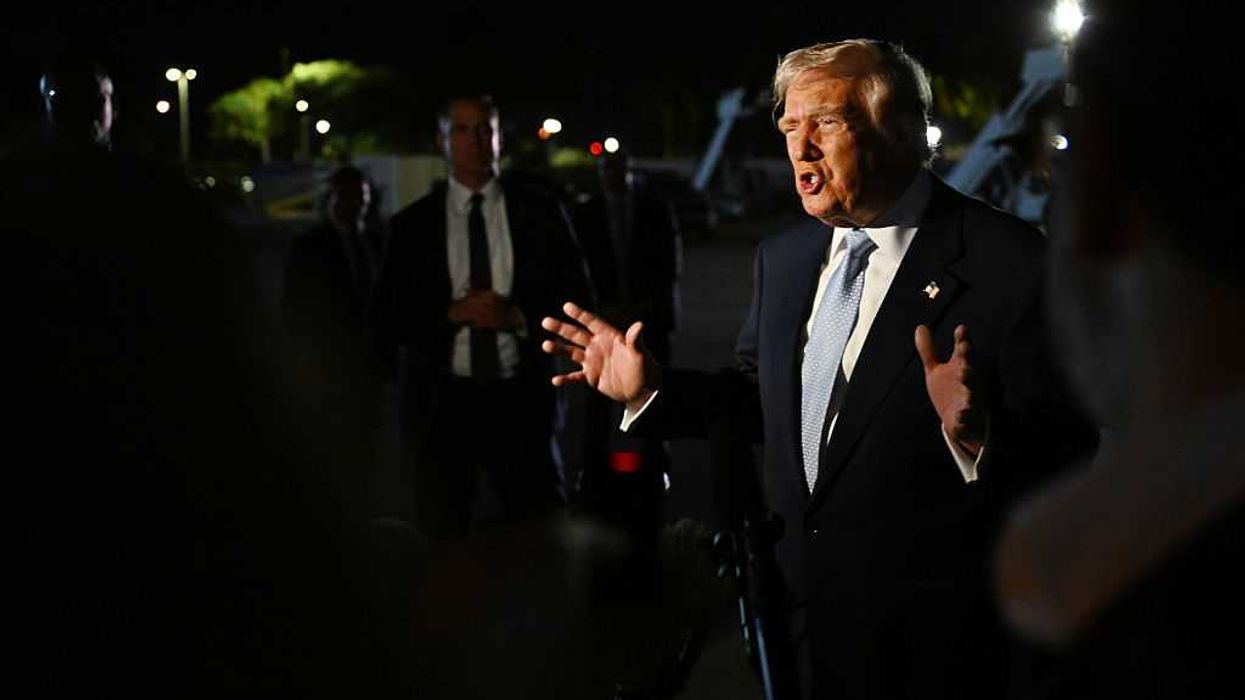Voters stood up for democracy this year, electing Democrats who campaigned heavily on preserving it. Take Minnesota, where Democrats are in charge of both chambers for the first time in eight years. Plus, Governor Tim Walz is asking his fellow Democrats to "think big" when it comes to voting issues. Gov. Walz of Minnesota joined The ReidOut to discuss.
Site Navigation
Search
Latest Stories
Start your day right!
Get latest updates and insights delivered to your inbox.
Top Stories
Latest news
Read More

As Australia bans social media for kids under 16, U.S. parents face a harder truth: online safety isn’t an individual choice; it’s a collective responsibility.
Getty Images/Keiko Iwabuchi
Parents Must Quit Infighting to Keep Kids Safe Online
Dec 24, 2025
Last week, Australia’s social media ban for children under age 16 officially took effect. It remains to be seen how this law will shape families' behavior; however, it’s at least a stand against the tech takeover of childhood. Here in the U.S., however, we're in a different boat — a consensus on what's best for kids feels much harder to come by among both lawmakers and parents.
In order to make true progress on this issue, we must resist the fallacy of parental individualism – that what you choose for your own child is up to you alone. That it’s a personal, or family, decision to allow smartphones, or certain apps, or social media. But it’s not a personal decision. The choice you make for your family and your kids affects them and their friends, their friends' siblings, their classmates, and so on. If there is no general consensus around parenting decisions when it comes to tech, all kids are affected.
According to More in Common, which recently surveyed parents in the U.S., U.K., France and Poland on their thoughts and experiences around online safety, 65% of U.S. parents are “very” concerned about their kids’ safety online, and another 28% are “somewhat” concerned (leaving 7% of parents not that concerned at all – a troubling number, even if it seems low).
And according to the researchers, deeper focus group sessions (which you can dive into by downloading the report here) showed many parents feel that other parents are undermining their ability to keep their children safe. Specifically, the researchers note that, “Differences in approaches between parents are seen as a source of tension, and a way for children to bypass the rules in their own household. This can lead to parents feeling powerless.”
Perhaps parents feel powerless because so often they are alone in this fight, given that the burden of responsibility for keeping kids safe online is lobbed squarely onto parents rather than onto the technology companies where it belongs. This is not by accident, or by default, but is a result of the democratic process failing to protect the most vulnerable among us – our children – from Big Tech. When there is no corporate accountability, the result is infighting and an inability for civil society to form a strong, united front.
We are in a divisive time in this country, politically, but we must not be divisive on this issue, and changing community norms is one of the best defenses we have right now against the risks our kids are facing. We know child sexual abuse material can be found on every platform. We know social media is problematic for a multitude of reasons for kids under 16 (and even older). The online realm, especially now that AI has exploded with essentially no guardrails and major support from the current administration, is only getting crazier and more dangerous. AI toys are the newest threat and should make every parent lose sleep at night.
Certainly not all kids are the same – what one child can handle online might be very different for the next child. And parents are the best judges of that. But let’s be real – not all parents are diligent or, as the More in Common research shows, all that concerned about the mental and physical risks posed to young people when they go online. We can be pro-tech and also pro-safety, but we have to be able to talk to each other and come to some agreement around what we, as a country, will allow for our children. But we won’t come to a consensus without first agreeing that it’s a collective problem with collective consequences.
There is legislation that will help to fight this problem and hold tech companies responsible for what happens on their platforms. And we must support this sort of policy action to get to the root cause. But as parents, the greatest power we have is our ability to come together. We must not let parental individualism get in our way of protecting our kids online.
Keep ReadingShow less
Recommended

selective photo of petaled flower
Photo by raquel raq on Unsplash
Planting Hope in a Hard Season
Dec 24, 2025
In an Advent reflection penned several years ago, Anne Lamott wrote, “even as everything is dying and falling asleep…something brand new is coming. Hope is coming….swords will be beaten into plowshares, spears into pruning hooks.
“This is a little hard to buy,” she admitted, “with a world stage occupied by—well, I’m not going to name names. But setting aside one’s tiny tendency toward cynicism,…in Advent — we wait; and hope appears if we truly desire to see it….we find it where we can….”
I want us to beat our cynicism and despair into useful tools to plant and grow that hope, don’t you? My most recent glimpse was something between “The Little Engine that Could” and “David and Goliath.” It arrived in an email from the head of the United Church of Christ Climate Hope Affiliates (CHA). The first CHA chapters were started in March 2025, and by the end of the year, they had started their eleventh chapter. Talk about planting hope in a hard season.
Before I share that hopeful story, let’s remember the cracked clay we must till for hope to grow.
This month, Miami elected its first Democratic mayor in nearly 30 years. The voter turnout? Twenty-one percent. On December 9, 2025, 79 percent of Miami voters stayed home. That’s a reminder of how hard it is to engage Americans in voting, let alone the work between elections.
Against this backdrop, the eleventh and newest CHA chapter was launched in East Lansing, Michigan, on November 1. Of the 22 who attended the launch, 10 became chapter members. They began with a four-part new group training, something few organizations would ask of new volunteer advocates. (We often get as little as we ask for.) Before the four sessions were even complete, they’d secured, prepared for, and completed their first meeting with a Congressional office. Many of their friends and acquaintances said their Congressman, Rep. Tom Barrett (R-MI), was notoriously difficult to reach.
Because of alleged vandalization outside of Rep. Barrett’s office, the office was closed, and the brand-new volunteers were told they’d be informed of the meeting location only a few hours beforehand.
“I honestly wondered if we would be meeting at all,” said Pastor John Schleicher, Lutheran Bishop Emeritus, who described the experience on the CHA national webinar in December.
Some chapter members had never met with a Congressional office, so they practiced once with the CHA staff trainer and twice on their own.
“I would underline how important those practices were for all of us to be able to speak both succinctly and extemporaneously,” Schleicher said, “and to engage in ‘deep listening’. As it turned out, the Congressman’s district director was more than gracious, setting us all at ease and granting us a full hour to talk.”
Three Michigan State University students sat in on the meeting. That’s real civics training. The Congressman and his aide shared a commitment to caring for veterans, and the group expressed their gratitude for that and for Rep. Barrett’s support for solar energy as a state representative.
The aide listened carefully to the volunteers’ personal stories and to their request: full funding of the Environmental Protection Agency (EPA). President Trump has called for a 55% cut to the EPA.
“We spoke of our hope for an ongoing relationship with the aide,” Schleicher continued. “He responded that we could be helpful in sharing important details and nuances in shaping bills Rep. Barrett might sponsor and/or support related to environmental and caring for creation issues.”
Knowing their Representative is a devout Catholic and avid reader, they asked the aide to pass on a copy of Laudato Si, Pope Francis’ encyclical On Care for Our Common Home.
“If this first meeting sounds too good to be true,” Schleicher concluded, “it did to us, too! Our advice as newbies in this CHA approach to advocacy is to lean on your faith that God is in this non-combative approach to relationship building with elected leaders. They may not be as completely close-minded or as captive to corporate, nakedly profit-oriented influences as we think. Pray for…staff members to show up in this gentler, more Christ-like, potentially more lasting way, willing to work with you for a healthier, more just world.”
“Even as everything is dying and falling asleep” Lamott reminded us, “…something brand new is coming. Hope is coming….in Advent — we wait; and hope appears if we truly desire to see it….we find it where we can….”
I’ve found hope in the work of these newly minted volunteer advocates and in a Congressional aide who was willing to listen to them.
Sam Daley-Harris is the author of “Reclaiming Our Democracy: Every Citizen’s Guide to Transformational Advocacy” and the founder of RESULTS and Civic Courage. This is part of a series focused on better understanding transformational advocacy: citizens awakening to their power.
Keep ReadingShow less

As screens replace toys, childhood is being gamified. What this shift means for parents, play, development, and holiday gift-giving.
Getty Images, Oscar Wong
The Christmas When Toys Died: The Playtime Paradigm Shift Retailers Failed to See Coming
Dec 23, 2025
Something is changing this Christmas, and parents everywhere are feeling it. Bedrooms overflow with toys no one touches, while tablets steal the spotlight, pulling children as young as five into digital worlds that retailers are slow to recognize. The shift is quiet but unmistakable, and many parents are left wondering what toy purchases even make sense anymore.
Research shows that higher screen time correlates with significantly lower engagement in other play activities, mainly traditional, physical, unstructured play. It suggests screen-based play is displacing classic play with traditional toys. Families are experiencing in real time what experts increasingly describe as the rise of “gamified childhoods.”
Parents walk store aisles searching for something that will excite the children on Christmas morning, yet we already know the truth. The toys we select will not compete with Minecraft® or Roblox® games like Dress to Impress® and 99 Nights in the Forest®, or with other digital universes where kids spend most of their creative energy. Children care about avatars, skins, upgrades, quests, weapons, and character packs. They care about customizing their online identities, cheat codes, and unlocking features that help them advance. Dolls, trucks, and building sets simply cannot hold their attention as well as digital play does.
This year, my family donated toys twice. Not because we want to purge clutter, but because the playroom tells the whole story. Many toys from birthdays still remain unopened in the closet. Others are played with once and never touched again. Yet the moment a tablet turns on, the excitement is instant. The dopamine hits from the rewards of progressing through a game are strong. The children want Robux, Minecoins, game passes, exclusive content, and digital tools that help them explore their online worlds. It becomes clear that parents are shopping in physical toy stores for an outdated model of childhood.
Retailers are falling even further behind. Childhood culture has shifted. Merchandise tied to the digital properties kids care about barely exists. Try finding quality items connected to 99 Nights in the Forest, KPop Demon Hunters®, or many of the other games that influence children’s online experiences. You will likely walk away empty-handed. The demand is high, and the audience is loyal, yet retailers are missing a significant financial opportunity.
This disconnect leaves parents frustrated, confused, and sometimes feeling guilty. We want to give something meaningful. We want to see genuine joy on our children’s faces. Instead, we often watch them unwrap toys that end up in the donation pile by Spring Break. At the same time, many parents feel a quiet worry building. We see how deeply these games pull our children in, and we instinctively sense that this level of immersion is not always healthy. The research reflects their concerns. Some families even notice changes in mood, patience, and attention when gaming becomes the center of play. Gaming is not a slight seasonal trend. It reflects a significant cultural shift in how children imagine, learn, and socialize.
I admit I disapprove of the nature of many of these games for the children in my family, yet I see the pressure they feel because all their friends are talking about the zombie-crazed deer in 99 Nights. The adage that asks whether you would jump off a bridge if your friends did no longer works. The answer is yes, but now parents are the ones providing the safety equipment so their children can jump and land as softly as possible.
As a former teacher and an early childhood specialist, I suggest shifting the focus this holiday season to experiences as gifts. Children may not hold on to physical toys, but they remember moments. Experiences support healthy development in ways that toys sometimes cannot. Families can consider museum memberships, robotics camps, art classes, sports clinics, concerts, creative workshops, or meaningful family outings. To keep the magic of unwrapping alive, parents can place a small related gift under the tree, such as a child-friendly camera for a year of museum visits, a nature explorer kit for an outdoor program, or art supplies that introduce an upcoming class.
Christmas feels different now, but it also offers an opportunity. I am mourning the decline of traditional toys, but parents can use this season to rethink how we protect, connect, and support our children in an evolving world.
The playtime paradigm shift is already here.
Janice Robinson-Celeste is a former educator and the founder of Successful Black Parenting Magazine, a multi-award-winning publication that empowers Black families. She is a Public Voices fellow of the OpEd Project in partnership with the National Black Child Development Institute.
Keep ReadingShow less

Amid division and distrust, collaborative problem-solving shows how Americans can work across differences to rebuild trust and solve shared problems.
Getty Images, andreswd
Where is the Holiday Spirit When It Comes to Solving Our Nation’s Problems?
Dec 23, 2025
Along with schmaltzy movies and unbounded commercialism, the holiday season brings something deeply meaningful: the holiday spirit. Central to this spirit is being charitable and kinder toward others. It is putting the Golden Rule—treating others as we ourselves wish to be treated—into practice.
Unfortunately, mounting evidence shows that while people believe the Golden Rule may apply in our private lives, they are pessimistic that it can have a positive impact in the “real” world filled with serious and divisive issues, political or otherwise. The vast majority of Americans believe that our political system cannot overcome current divisions to solve national problems. They seem to believe that we are doomed to fight rather than find ways to work together. Among young people, the pessimism is even more dire.
The good news is, we don’t need a Christmas miracle to make things better. We know from experience that Americans can overcome deep division: it is indeed possible to work across differences in a way that fosters respect and positive relationships and achieves remarkable results in the process.
For over two decades, we have successfully addressed critical issues at the national, state, and local levels through what we and others call “collaborative problem-solving.” We’ve found that so long as people agree there is a problem to solve, they can work together productively. Even people who assume they are inalterably opposed can find ways to build durable solutions and, in many instances, surprising friendships.
For example, in 2012, the Convergence Center for Policy Resolution convened a few dozen deeply divided leaders on K-12 education and engaged them in a collaborative problem-solving project. One participant, Gisele Huff, then head of the conservative Jaquelin Hume Foundation, was a strong critic of teachers’ unions and an advocate for school choice. She said she joined the project mainly to counteract union views and “had no illusions about the work product being anything worthwhile.
When they engaged in the collaborative problem-solving process, Gisele and the union representatives were surprised to see that they agreed on a lot. Gaps remained, and still remain, on issues like school choice. But they also found that when they focused on a common problem rather than defeating each other’s agendas, and broadened their perspectives, they were able to find enough common ground to form a more creative and compelling vision for the future of K-12 education than any party had before they met.
In this process, Gisele formed a positive relationship with her former adversary, Becky Pringle, now president of the National Education Association, the nation’s largest teachers’ union. They have supported each other through family challenges and even did something previously regarded as unthinkable: they went on a joint speaking engagement to spread the gospel of “learner-centered education.”
The collaboration was so successful that in 2015, a wide array of participating groups formed a new organization called Education Reimagined. Since then, the organization has been successfully moving its vision into action through grassroots efforts across the country.
The example of Gisele and Becky is one of many similar stories. If philosophical adversaries like them can generate and work to implement shared solutions, there is no reason why others—in government at all levels, businesses, nonprofits, academia, religious institutions, community groups, and more—cannot do the same.
The starting point for success lies in cultivating a “collaborative mindset.” Aspects of this include: seeing that conflict can be constructive and can push thinking to a higher level; giving others the benefit of the doubt rather than making premature assumptions; cultivating a practice of genuine curiosity to really understand each other; believing that win-win solutions are possible; and entertaining the idea that no one person, perspective or ideology has all the answers and that better solutions are likely to emerge by integrating collective wisdom. People who practice this mindset, or at least stay open to it, are more likely to have success employing the key steps entailed in any collaborative problem-solving effort.
There is no reason why most people cannot try these methods in a surprisingly wide array of circumstances. With good faith and honesty, this approach can help solve tough problems far more effectively and amicably than most would ever imagine.
We know we can do better as a nation. This mindset and simple steps hold exciting potential to help foster a cultural shift toward a deeply held aspiration of the season: to bring the “holiday spirit” into our private and public lives.
Mariah Levison is the organization’s current CEO. They are co-authors of From Conflict to Convergence: Coming Together to Solve Tough Problems
Keep ReadingShow less
Load More
















